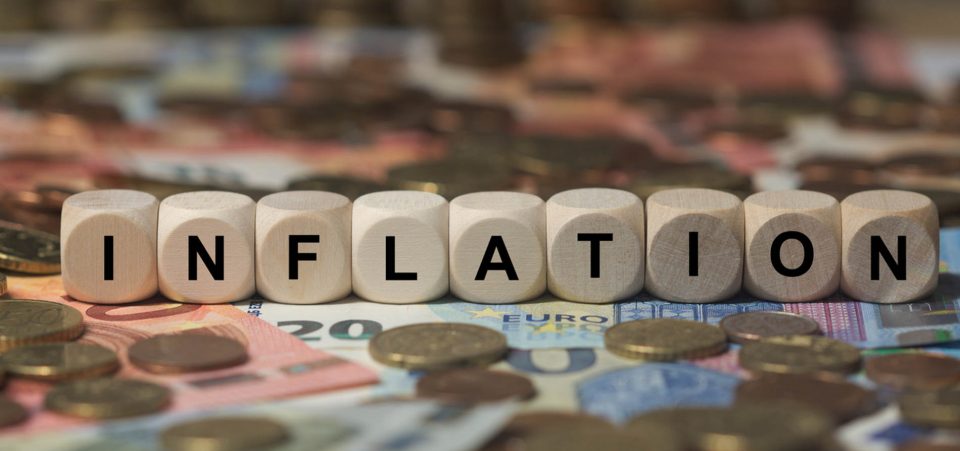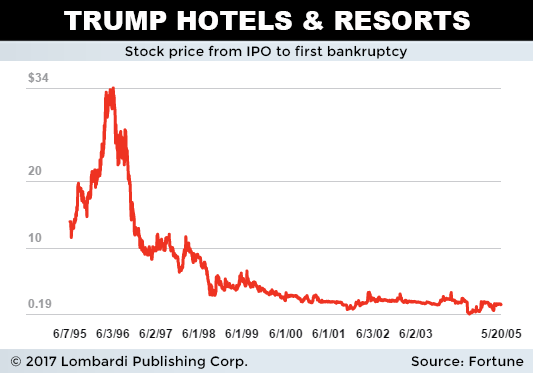Risk of U.S. Hyperinflation Growing
Donald Trump won the U.S. presidency largely on the pledge to reinvigorate American manufacturing and spur economic growth. This was the impetus that would “Make America Great Again.” But in doing so, could he be planting the seeds for hyperinflation in 2018?
What is hyperinflation? Some define it as a situation where prices spiral out of control, making the concept of traditional metrics of inflation meaningless. Some definitions ascribe an actual month-over-month increase of 50% in prices as hyperinflation. Whichever definition conforms to your sensibilities, it’s bad news for consumers.
Hyperinflation in the United States in 2018 may seem like an implausible proclamation, but it’s not as far-fetched as it sounds. Is U.S. hyperinflation imminent? Probably not. It would undoubtedly take several factors to hit at the same time and with full force, but stranger things have happened. Economist Nassim Taleb calls unforeseen events like these “black swan” events. And yes, they can happen.
Our first bit of evidence pointing to possible hyperinflation in 2018 relates to monetary policy. If the Trump administration has its way, the monetary policy will (continue to) be ultra-loose. How do we know this? The president himself has referenced this point numerous times over the past 18 months. “She is a low interest rate person, she’s always been a low-interest-rate person, and let’s be honest, I’m a low-interest-rate person,” Trump added when commenting on Federal Reserve Chairperson Janet Yellen on the campaign trail. (Source: “‘Low-interest-rate’ Trump wants to replace Yellen, refinance U.S. debt,” MarketWatch, May 5, 2016.)
This dovetails perfectly with Trump’s extensive use of debt financing to build his real estate empire. While on aggregate, Trump has been fantastically successful in his business dealings, excessive debt has also almost buried him on a couple of occasions.
For example, when Trump Hotels & Resorts (THR) went public in 1995, long-term debt on its balance sheet amounted to “only” $494.0 million. By 2002, total debt expanded to $2.1 billion and its leverage ratio ballooned to 27 (a similar leverage ratio to Lehman Brothers Holdings Inc. when it filed for Chapter 11 bankruptcy). By 2003, THR lost $87.0 million, as interest costs totaling $227.0 million far exceeded operating earnings $135.0 million; a gap which was steadily widening over time. The end result: THR suffered through two separate bankruptcies in 2004 and 2009, and the main Trump casino operator never finished in the black.
The ultimate takeaway here is that Trump is no stranger to leverage, and there’s extensive evidence to believe he’ll look to expand the debt ceiling in office.
One way of doing this would be to expand the years of maturity on Treasury Securities to avoid paying back the principal until a much later date. Treasury Secretary Steve Mnuchin is on record exploring the possibility of both 50-year and 100-year Treasury bonds, with economic adviser Larry Kudlow also on board. “I want the U.S. Treasury… to issue…100-year bonds as soon as possible, to take advantage of generational interest rate lows that we will not see again…” he said. (Source: “Larry Kudlow: US should issue 100-year bonds ASAP,” CNBC, December 9, 2016.)
This begs the question: If the United States is so indebted that it’s forced to issue 100-year Treasury Securities to expand deficit spending, can the debt endgame really be far off? I mean, it’s absurd to think about debt in centennial terms when the average lifespan in the U.S. in about 80 years old. Who would lend the U.S. government their hard earned money at 2.25% or 2.75% for the rest of their lives? And their children’s and possibly, grandchildren’s lives? Would this even be a serious consideration if the United States was on sound financial footing?
That, my friends, was a rhetorical question. Whether this leads to hyperinflation in 2018 or a later date, this move reeks of the type of desperation only the near-bankrupt would employ.
Now, when we combine the intent to introduce later-maturing debt instruments with budget-busting spending, we have the flammable conditions needed for hyperinflation in 2018 and beyond. While Trump has supported drastic spending cuts in places like the State Department, for the most part, the biggest swaths of the Federal budget are left untouched or expanded. A proposed 37% reduction in an annual State Department budget of $50.1 billion would only save the government $18.5 billion; peanuts in comparison to the spending spree that lies ahead.
For instance, there’s Trump’s vaunted $1.0-trillion infrastructure plan. This is the plan to modernize America’s decaying public works projects. From the beginning of his campaign to the present time, Trump’s infrastructure plan has remained the bedrock of his “Make America Great Again” platform. In late February 2017, Trump opined: “Infrastructure—we’re going to start spending on infrastructure big. Not like we have a choice. It’s not like, oh gee, let’s hold it off.” (Source: “Trump pledges to spend ‘big’ on infrastructure,” CNBC, February 27, 2017.)
Next, we have the question of increased military spending. Trump has been a vocal proponent of boosting military spending, and even modernizing the nation’s nuclear arsenal. These plans would require a big influx of money. A White House budget official, who released the plan via conference call, said the administration would propose “increasing defense by $54 billion or 10 percent.” (Source: “Trump seeks ‘historic’ U.S. military spending boost,” Reuters, February 28, 2017.)
But perhaps the most worrisome aspect of the looming possibility of hyperinflation in 2018 and beyond is entitlement spending. More specifically, the lack of will by this administration to cut it—at least not yet. Treasury Secretary Mnuchin is on record saying that these entitlements will not be touched in Trump’s first proposed budget. Without entitlement spending scaled back, it’s practically impossible for the administration to prevent the national deficit from rising at an out-of-control pace.
Right now, about 59% of the entire U.S. budget is spent on social security, various forms of medical insurance and safety net program. The cost of these programs is set to skyrocket in the near future. Although the official government and intragovernment debt is only somewhere around $20.0 trillion, the U.S. deficit including unfunded liabilities is 12 times higher than the official total. If these are fully honored, the United States will have no choice but to ramp up the printing presses at an exponential rate.
The fact that Trump is leaving these programs alone only delays the inevitable.
Is Hyperinflation About to Hit U.S. Shores?
How likely is hyperinflation in the U.S.? Before we can ascertain if hyperinflation is coming, it’s useful to understand the causes of hyperinflation. What is the cause of hyperinflation? There are two primary origins.
The first occurs when consumers begin to lose faith in a country’s currency, prompting them to purchase anything of value not nailed down. When the populace no longer believes in the value of a currency, they will purchase goods beyond immediate need in expectation that the currency will no longer hold its value.
The second cause of hyperinflation, which often dovetails with the first cause, is government over-indebtedness. As the over-extended government prints more cash to plug budget gaps, the monetary base expands, diminishing the value of existing dollars in circulation. The more currency in circulation, the less each unit is worth. Simple supply and demand dynamics.
A famous instance of both types of the described hyperinflation occurred in Zimbabwe in the early 2000s. The government essentially printed excessive amounts of money to cover budget deficits faster than real GDP could support. This, compounded by a shortage of real goods and a populace willing to unload the freshly-minted currency at whatever cost necessary, resulted in month-over-month inflation skyrocketing from 585% in 2005 to 231,150,888.87% in 2008! The insidious effects of hyperinflation had completely decimated the economy and all means of price discovery.
| Country | Month with highest inflation rate | Highest monthly inflation rate | Equivalent daily inflation rate | Time required for prices to double |
|---|---|---|---|---|
| Hungary | July 1946 | 1.30 x 1016% | 195% | 15.6 hours |
| Zimbabwe | Mid-November 2008 (latest measurable) | 79,600,000,000% | 98.0% | 24.7 hours |
| Yugoslavia | January 1994 | 313,000,000% | 64.6% | 1.4 days |
| Germany | October 1923 | 29,500% | 20.9% | 3.7 days |
| Greece | November 1944 | 11,300% | 17.1% | 4.5 days |
| China | May 1949 | 4,210% | 13.4% | 5.6 days |
(Source: “R.I.P Zimbabwe Dollar,” CATO Institute, February 5, 2009.)
Supply Shortages in the U.S. Economy?
The threat of hyperinflation in 2018 in the U.S. economy likely won’t occur because of a bloated balance sheet alone. Other factors will contribute to such circumstances.
As in the Zimbabwe example, serious price inflation could be making a comeback in the U.S. if free trade gets clawed back. The repeated threats by Trump to institute border taxes are well known, but what isn’t is the nasty rise in inflation that could result.
Quite simply, the higher input costs of materials resulting from a trade war could result in finished goods prices much higher than forecast. It could also lead to a shortage of certain goods, which would exert upwards pressure on prices. This has already happened in the U.S. four decades ago, although not at hyperinflationary levels.
Who could benefit from hyperinflation in U.S? The U.S. government debt, mainly. Although hyperinflation in 2018 or beyond would diminish the real weight of the U.S. debt precipitously, immense damage would be wrought elsewhere. America’s credit rating would be destroyed, as would the ability to procure imports. America would likely have to borrow funds from the International Monetary Fund, who would impose strict limits on spending and finance allocation. Most people’s purchasing power would be destroyed completely, with an inability to purchase even basic essentials. Crime would skyrocket, as people would resort to any means necessary to feed their families. A scary Hunger Games-type dystopia would await.
Only the protection of gold could offer protection from the carnage hyperinflation in 2018 and beyond could cause. The modest outlook in gold prices forecast 2017 could easily jump much higher if the whiff of inflation takes hold in the market. All eyes will be focused on Steve Mnuchin and Congress as the current debt ceiling expires on March 15, 2017, and the subsequent budget proposal in the months ahead.
If carte blanche towards spending is given, along with border taxes and continued gaping budget deficits continue, the odds of hyperinflation in 2018 and beyond increase incrementally.







